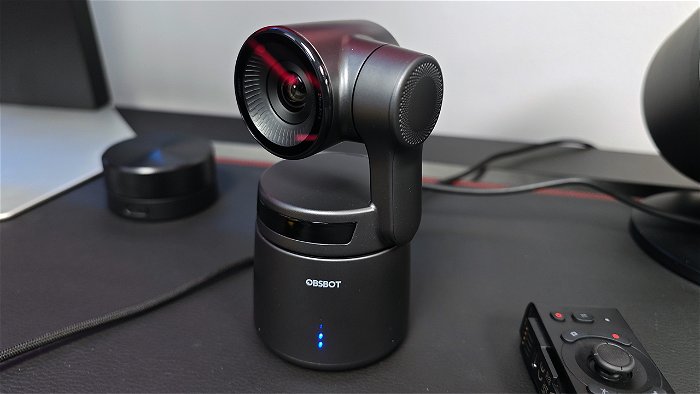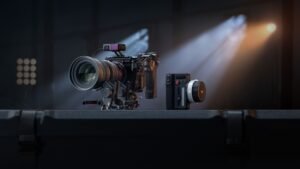OBSBOT has released a new smart camera that is arguably its most versatile to date, the OBSBOT Tail Air. The camera can be used in virtually any scenario, whether live streaming or recording and doesn’t need to be tethered to a computer to do it. It is everything that the OBSBOT Tiny and the original OBSBOT Tail has to offer with a lot of really cool quality-of-life upgrades.
The OBSBOT Tail Air is not something that I would call a webcam despite our being accustomed to devices like this being set up on our computers, but that is small thinking when we think about the Tail series. Yes, you can set it up as a webcam, but that is only the beginning. Like the OBSBOT Tail before it, the camera is capable of recording internally on a MicroSD card, with its own battery and controls via the OBSBOT Start phone app.

The specs on the OBSBOT Tail Air compared to the original Tail need to be explored because some of them will cause some confusion. The Tail Air has a 1/1.8” CMOS Sensor, an improvement from its predecessor’s 1/2.3” sensor, 8.4 million pixels that are 2µm in size, compared to the 12.4 million pixels at 1.55µm per pixel.
The larger pixels on the OBSBOT Tail Air will make images clearer (especially when zooming) compared to the Tail, which has pixels roughly 25% smaller. The zoom on the Tail Air is slightly limited, though. They provide a 4x Digital Zoom compared to the Tail’s 3.5x Optical Zoom (thanks to their lens system) and a 10x hybrid zoom. I think that a camera like this doesn’t require a 10x zoom, although it would have been perfect if the optical zoom was added into the Tail Air for a clearer picture.
The previous model has something that the Tail Air doesn’t—a 2K resolution, a faster frame rate of 60fps, and a slow motion frame rate of 240fps. However, the OBSBOT Tail Air provides 1080p and 4K resolutions up to a maximum of 30fps, which is adequate for standard video recording but may not be satisfying if you desire the smooth flow that a higher frame rate can deliver.

However, the OBSBOT Tail was larger than the Tail Air, measuring 20mm taller and weighing 265g more, almost twice the weight of the Tail Air. This makes the new model more inconvenient to carry around during outdoor shooting sessions. In contrast, the Tail Air is optimized for superior low-light video recording with an f/1.8 aperture. Furthermore, unlike its predecessor, manual focus can be configured.
The cameras have built-in microphones and can connect to an external microphone using a 3.5mm jack. This provides plenty of sound options while filming. The Tail Air can be mounted upside down, and the recording and streaming can occur simultaneously. The camera can charge through USB-C, Power over Ethernet Cable (if you have the USB-C to Ethernet Adapter), or an external base that enables 360-degree rotation.
Setting up the camera requires more than plug and play. If you intend to use it away from your computer, connect it using the OBSBOT Start app. You can control all aspects of the camera, such as exposure, position, and other settings, from the app.

Tracking can also be turned on either via the app or using hand gestures that will allow you to turn tracking on and off as well as zoom in and out. You can stream directly from your phone using the OBSBOT Tail Air, or you can record directly to the camera on the MicroSD card. You also need the MicroSD card to install any firmware updates to the Tail Air. The only limit to this method is that you can only connect to one camera at a time.
You have many options if you want to connect to your computer. It can be a webcam by turning on UVC mode either through the OBSBOT Start app on your phone or the OBSBOT Webcam app on your computer. You can also connect via RTSP (e.g. you would insert the camera as a media source using its unique IP address); you don’t necessarily need to be wired to do it.
Another excellent method is the NDI connection, meaning that you can have the cameras anywhere connected to the same wifi you are using. There is a lot of setup to get this going, and you need to purchase a separate NDI license for each camera you buy, but there is virtually no limit to the number of cameras you can add with these methods. When you set it up, you will have a full TV Studio at your disposal.

The OBSBOT Tail Air’s $499 USD price tag, however, will not be quick to encourage you to fill your setup with extra units. If you want to get a camera, though, that will be your camera operator for you as you parkour, skate or do anything else with a lot of movement and do a good job doing it, then this is worth a buy, despite the original’s oft-superior specs. Its brand-new features make it feel like a whole new camera.






